New Delhi: The India-Middle East-Europe Economic Corridor announced during the G20 Summit in New Delhi earlier this month is the latest economic and transport corridor in which India has been included. Here is a look at the emerging economic and transport corridors involving India.
India-Middle East-Europe Economic Corridor
The India-Middle East-Europe Economic Corridor (IMEC) is a planned economic corridor that aims to bolster economic development by fostering connectivity and economic integration between Asia, the Persian Gulf and Europe. The IMEC comprises an Eastern Corridor connecting India to the Gulf region and a Northern Corridor connecting the Gulf region to Europe. It will include a railway and ship-rail transit network and road transport routes. On September 10, the Memorandum of Understanding (MoU) was unveiled during the 2023 G20 New Delhi Summit by the governments of India, the US, the United Arab Emirates (UAE), Saudi Arabia, France, Germany, Italy, and the EU.
International North-South Transport Corridor
The International North-South Transport Corridor (INSTC) is a 7,200-km-long multi-mode network of ship, rail, and road routes for moving freight. India, Iran and Russia had in September 2000 signed the INSTC agreement to build a corridor to provide the shortest multi-model transportation route linking the Indian Ocean and the Persian Gulf to the Caspian Sea via Iran and St. Petersburg. From St Petersburg, North Europe is within easy reach via Russia. The estimated capacity of the corridor is 20-30 million tonnes of goods per year. The route primarily involves moving freight from India, Iran, Azerbaijan and Russia via ship, rail and road. The objective of the corridor is to increase trade connectivity between major cities such as Mumbai, Moscow, Tehran, Baku, Bandar Abbas, Astrakhan and Bandar Anzali.
India-Myanmar-Thailand Trilateral Highway
The India-Myanmar-Thailand Trilateral Highway (IMT-TH) is a 1,360-km-long four-lane road under construction to boost connectivity between India’s northeastern region and Southeast Asia. The road runs from Moreh in Manipur to Mae Sot in Thailand. The road is expected to boost trade and commerce in the ASEAN–India Free Trade Area, as well as with the rest of Southeast Asia. India has also proposed extending the highway to Cambodia, Laos and Vietnam. The proposed 3,200-km route from India to Vietnam is known as the East-West Economic Corridor. The route from Thailand to Cambodia and Vietnam became operational in 2015.
Kaladan Multimodal Transit Transport Project
The Kaladan Multimodal Transit Transport Project (KMTTP) is a joint project between India and Myanmar. The Kaladan multimodal project connects Kolkata port with Myanmar’s Sittwe Port by sea, Sittwe to Paletwa in Myanmar via river Kaladan, Paletwa to the border of India, and Myanmar via road and further ahead to Lawngtlai, Mizoram, by road. The project was launched under New Delhi’s Look East Policy in 1991, and currently, the Narendra Modi government undertook this as an Act East re-modelled policy.
Mekong-India Economic Corridor (MIEC)
The Mekong-India Economic Corridor (MIEC) involves integrating the four Greater Mekong Countries of Myanmar, Thailand, Cambodia and Vietnam with India through its east coast. It is proposed to connect Ho Chi Minh City (Vietnam) with Dawei (Myanmar) via Bangkok (Thailand) and Phnom Penh (Cambodia) and further linking to Chennai in India via sea. Integration with India is likely to add momentum to corridor development due to growing trade and investment linkages between India and Mekong countries. The MIEC is expected to augment trade with India by reducing travel distance between India and Mekong countries and removing supply-side bottlenecks.
BIMSTEC Transport Corridor
The Bay of Bengal Initiative for Multi-Sectoral Technical and Economic Cooperation (BIMSTEC), which came into existence in 1997, comprises seven countries lying in the littoral and adjacent areas of the Bay of Bengal – Bangladesh, Bhutan, India, Myanmar, Nepal, Sri Lanka and Thailand.
Membership in the bloc allows India to engage more with the extended neighbourhood in Southeast Asia under New Delhi's Neighbourhood First Policy via northeastern India. The proposed connectivity project is envisaged to be a multimodal one. Convinced that connectivity is vital to promote regional integration, the leaders of the BIMSTEC member states during their Goa Retreat in October 2016 directed the preparation of a master plan for BIMSTEC connectivity. The 15th Ministerial Meeting held at Kathmandu, Nepal, in August 2017, tasked the BIMSTEC Transport Connectivity Working Group (BTCWG) to develop the draft Master Plan. Accordingly, the process of drafting the Master Plan was initiated at the Second BTCWG Meeting held in Bangkok, Thailand, in November 2017 with technical assistance from the Asian Development Bank (ADB).
Bangladesh-Bhutan-India-Nepal Motor Vehicles Agreement
The Bangladesh-Bhutan-India-Nepal (BBIN) Motor Vehicles Agreement The BBIN Motor Vehicles Agreement (MVA) was signed in June 2015 at the BBIN transport ministers meeting in Thimpu, Bhutan. The agreement will permit the member states to ply their vehicles in each other's territory for transportation of cargo and passengers, including third-country transport and personal vehicles. Each vehicle would require an electronic permit to enter another country's territory, and border security arrangements between nations' borders will also remain. Cargo vehicles will be able to enter any of the four nations without the need for the trans-shipment of goods from one country's truck to another's at the border. The BBIN project suffered a setback in 2017 when Bhutan temporarily opted out of it after being unable to get parliamentary approval for the MVA.



